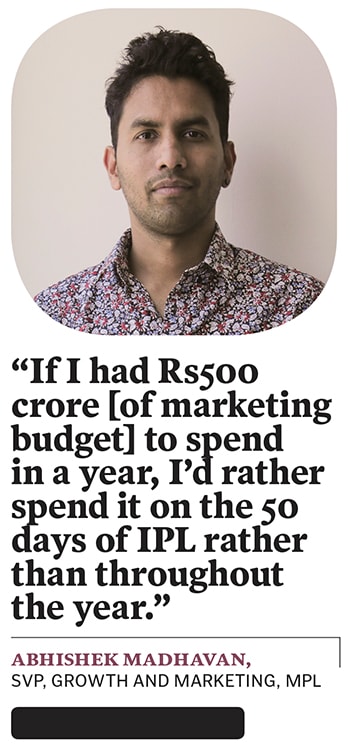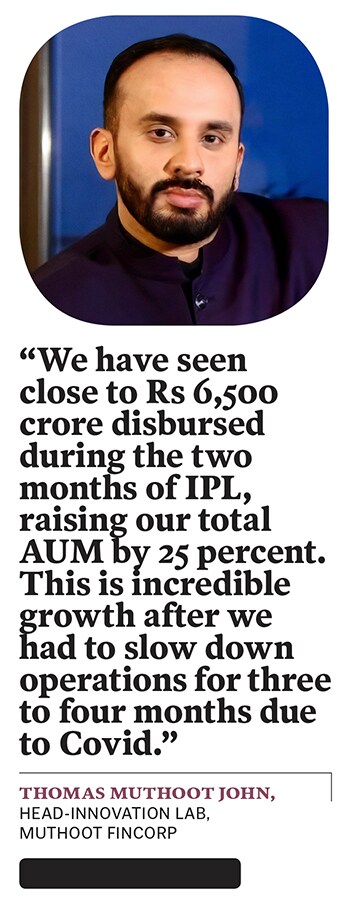Perfect Match: Why brands love the Indian Premier League
As IPL gets bigger in scale and viewership, marketing tie-ups with the tournament are fetching greater visibility and returns for brands across sectors
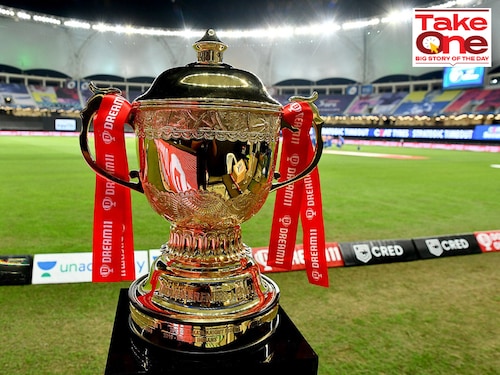

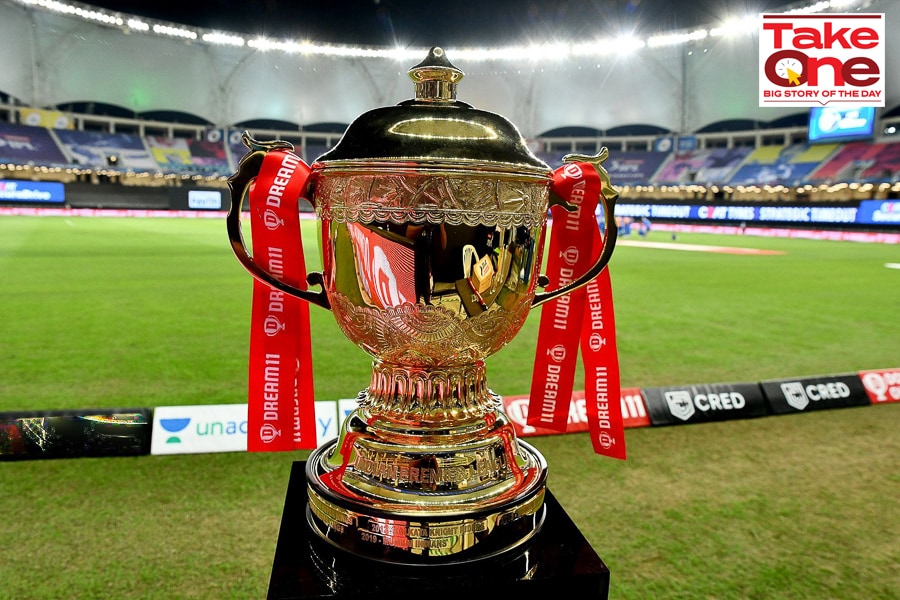 Photo - Samuel Rajkumar / Sportzpics for BCCI
Photo - Samuel Rajkumar / Sportzpics for BCCI
There was a time menstrual hygiene startup Niine struggled to extract payment from stockists for nearly 40 days. The brand was nascent, barely visible and was expected to wither away in the face of competition from multinational behemoths like Procter & Gamble (P&G) and Johnson & Johnson (J&J). Not anymore. “Now, all our distributors know what Niine is, markets that didn’t give us shelf space earlier are calling us to place orders, and stockists are paying up within 15 days,” says Sharat Khemka, founder of Niine.
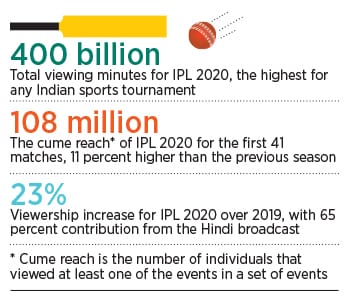
Khemka’s magic wand has been an association with the Indian Premier League (IPL) franchise Rajasthan Royals as its principal sponsor. In September 2020, the three-year-old company tied up with the then-Steve Smith-led team for a logo placement on the back of the jersey. Despite the team ending up at the bottom of the table, Khemka’s business has only gone north since. Following the two-month-long tournament, played in the United Arab Emirates last year due to the Covid surge in India, Niine gained a 3 percent pan-India market share, and upwards of 9 percent in the western state. In its first three years of operations, the company raked in Rs14 crore per month in sanitary napkin sales, while following two months of the IPL, the number shot up to Rs20 crore. “Our competitors like P&G and J&J have now started taking us seriously. There is no better property than IPL to improve a brand’s image,” adds Khemka.
Be it sponsorships (with teams as well as the league) or on-air tie-ups, an IPL association is moving the marketing needle for brands, bringing an uptick in brand awareness among consumers. With 400 billion viewing minutes during its last edition—the largest viewership for an Indian sports tournament—at a time the country was under a house arrest due to the pandemic, it has brought about a visibility windfall for its advertising partners.
2020 title sponsors Dream11, the fantasy league platform which bagged the rights for Rs 222 crore after Vivo stepped away for a year, crossed 100 million in registered users during the tournament. The company that conceptualised six ad films starring MS Dhoni, Rohit Sharma, Rishabh Pant, Hardik Pandya, Shikhar Dhawan and Jasprit Bumrah championing gully cricket, and nine 10-second films goading fans to pick their fantasy teams, experienced a 44.4 percent surge in traffic during the final match as against the 2019 one. “As online fantasy sports is entirely based on live sporting events, it was a good opportunity for us to be visible at different fan touchpoints. Pitch report, toss, giving the ‘Dream11 GameChanger of the Match’ to the cricketer with the most fantasy sports points and so on were some richly organic moments where fans connected and interacted with our brand,” says Vikrant Mudaliar, chief marketing officer, Dream Sports & Dream11. Mudaliar added that they served more than 80 million requests per minute during the tournament.
Mobile esports platform MPL not only advertised during the IPL but also sponsored a couple of teams (Kolkata Knight Riders or KKR and Royal Challengers Bangalore or RCB) and signed on RCB captain Virat Kohli as its brand ambassador. “Approximately 30 to 40 percent of our marketing budget was allocated for the IPL. In terms of advertising, we had four to five slots during every match throughout the season,” says Abhishek Madhavan, SVP, growth and marketing, MPL. The returns? MPL’s user base grew 10x through the entire year and between 1.5 and 2 times during the tournament. “We started the year around 40 million users and ended around 70 million, most of the traction came during the IPL,” says Madhavan, who is looking to double his IPL ad spends this year. “If I had Rs500 crore to spend in a year, I’d rather spend it on the 50 days of IPL rather than throughout the year because the amount of viewership it’s able to generate is huge for anyone looking to build a brand.”
***********
Not just brands with a connection to sports, but even those far removed from it are looking to latch on to the IPL bandwagon to amp up their visibility. Consumer electronics brand boAt was the audio sponsor for six teams—it released limited edition products with five teams and bagged a branding on the helmet for Kings XI Punjab (now Punjab Kings). “Our website traffic increased by 50 percent due to the IPL, especially since its last leg that coincided with the Dussehra-Diwali festival season,” says Damandeep Singh Soni, VP, growth. Edtech startup upGrad spent almost its entire branding budget in the IPL quarter on the tournament to see its brand searches rise by 100 percent in the initial phase, and then settle at an enviable 50 percent towards the latter half of the tournament. “From a business metrics/ROI point of view, there are much better channels where you can generate leads and get conversions at a much lower cost. But the scale that IPL gives you, the awareness that it brings among consumers is something else,” says Arjun Mohan, CEO - India, upGrad.
Last year’s official IPL partner Cred, with its clutter-breaking ads featuring Bappi Lahiri, Madhuri Dixit-Nene, Anil Kapoor, Govinda, Udit Narayan and Alka Yagnik poking fun at themselves, is said to have added 2.4 million new users during the two months. The trend was confirmed halfway through the tournament by Shailendra J Singh, managing director at Sequoia Capital, a Cred investor, who tweeted that the app has seen 6-7x daily sign-ups since the launch of the IPL campaign. While the fintech brand declined an interview with Forbes India or to confirm the numbers, ads and marketing portal Afaqs quoted AppAnnie, a global provider of mobile data and analytics, to claim that downloads of the app increased 8x compared to the pre-IPL days.
“Right from imagery to consumer engagement to brand linkages, IPL lets you do everything under one roof. Therefore, traditional as well as new-age companies have found their way to embark on the IPL journey and embrace the kind of opportunities it offers,” says Vinit Karnik, business head, GroupM ESP Properties.
Many brands have attempted to leverage such opportunities during the tournament by launching products that help differentiate themselves. Muthoot Fincorp, the non-bank headquartered in Kerala, part of the 134 years old Muthoot Pappachen Group, picked IPL to foray into the financial landscape of the north and the east, where it is launching the latest of its 4,500-odd branches. A first-time IPL endorser in 2020 with RCB, the company rolled out an interest-free gold loan for its customers—mostly MSME owners and small traders—to coincide with the tournament.
The association brought Muthoot Fincorp a 54 percent spike in brand awareness from its pre-IPL days. “We logged about 140 million digital impressions and received close to 20 lakh inquiries at our branches and call centres during and post-IPL,” says Thomas Muthoot John, head-innovation lab. “We have seen close to Rs 6500 crore disbursed during the two months of IPL, raising our total AUM by 25 percent. This is incredible growth after we had to slow down operations for three to four months due to Covid.”
The strategy of a big-bang, differentiated IPL-focussed product has also yielded dividends for My11Circle, the fantasy games platform of Games24x7, in a sector crowded by over 150 players. Launched in 2019, My11Circle devised a format in which users could pit themselves against cricket legends like Shane Watson, Sourav Ganguly and Rashid Khan (with VVS Laxman as their latest signing). “We took this game to the users during the IPL, using TV and Hotstar to create brand recall. In a year and a half of our operations, we are among the top three players in the market,” says Saroj Panigrahi, the VP of My11Circle. From IPL 2019 to 2020, the platform saw a 9x increase in contest entry amount, while total player registrations have grown eight times compared to the 2019 edition, to reach 17-million-plus. “Our focus at this point is to acquire as many users as possible and keep entertaining them with new and innovative proposition,” adds Panigrahi.
************
While the IPL has unfurled visibility opportunities for legacy and startups brands alike, Bhairav Shanth, the MD and co-founder of ITW Consulting, feels the pendulum has conclusively swung from legacy brands in its early days in 2008, when the tournament started, to startups now. “Back then, except a few, most of the advertising brands were FMCGs, automobiles etc. The advertising ratio was 90:10 for legacy companies. Now it’s 70:30 in favour of startups. Even among legacy brands like Tata Motors, the advertisement tie-up for 2020 was for a new product like Altroz,” says Shanth.
While for legacy brands, adds Shanth, advertising is a tool to create spontaneous recall and build the product category, startups are far granular in their analysis of consumer behaviour, meticulously monitoring user acquisition, growth, behaviour and monetisation, and targeting a specific demography. Just like Khatabook, a Bengaluru-based digital book-keeping startup, did channelling $1.2-$1.5 million on marketing spends during IPL 2020 through an association with digital broadcaster Disney+Hotstar.

Says Ved Prakash Yadav, VP, growth and marketing, Khatabook: “When MS Dhoni—our brand ambassador—came out to play, Khatabook’s banners would appear on the screen. Second, we did an exclusive property on Hotstar, shot with Ashish Nehra, Irfan Pathan and Gautam Gambhir, making them go through the memories of how they started their career.” The campaign had a regional focus and used eight languages, one of the factors contributing to a high click-through rate across various digital platforms. Khatabook claims to have reached more than 50 million unique merchants and the campaign also helped them effectively re-engage with users who had fallen dormant during the Covid lockdown period. “Post and during the IPL, we saw about 1 million dormant users come back to our platform. For the existing users, engagement increased by 30 to 40 percent,” says Yadav.
The combined broadcast offering of Star Sports on TV and Disney+Hotstar for digital streaming also opens up the doors for a wider bouquet of brands with disparate financial might. “IPL offers a solution for every advertising need. One needs to have national ambitions to advertise on TV during IPL—the on-air association is high-reach but certainly expensive entry-level costs ,” says Navin Khemka, the CEO of MediaCom South Asia. “Having said that, digital viewership, which is emerging and growing fast now, gives you a segmented audience at an efficient cost—an exposure on Disney+Hotstar is able to dissect the audience based on geography, age group etc., and give you the cuts that you are able to afford. That apart, one can always tie up with one of the teams for local activations and run the TVC nationally or locally in regional networks for smart, lower-cost alternatives.”
**********
While startups dominated the advertising space in IPL 2020, it doesn’t necessarily mean legacy brands are turning their face away. While they have a headstart in communicating with consumers outside of the IPL too, cricket, and especially IPL, remains a key lever for engagement and long-term brand-building. For hardware company Astral Pipes, advertising during IPL is a strategy to enter the mindspace of its core customers—plumbers—and trigger recall every time they are asked to renovate a bathroom. “Which is not every day. We don’t see an immediate rise in sales due to the IPL, but get immense visibility through the tournament,” says Kairav Engineer, its VP, business development. “For two months in a year, IPL is the national pastime. And due to slashed data prices and increased access to smartphones, the games have reached unprecedented corners of the country. If you track Hotstar metrics, a few million people are watching IPL matches at any given time.”
Astral spends about Rs15 crore for IPL-centric brand play, about 20 percent of its overall marketing budget, betting big on winning horses. “For our main business of pipes, we are sponsoring Mumbai Indians, Chennai Super Kings and KKR in 2021, who hold 10 championship titles out of 13. Obviously, these are expensive picks, but they have a cult-like following in their respective states and give us all-round exposure,” adds Engineer. Having three teams also ensures Engineer that an Astral logo is visible in at least 39 matches. “In matches where Astral-sponsored teams play each other, the exposure is doubled.”
The advertising strategies are also tweaked by the weekly viewership patterns. Khemka of MediaCom says their research shows the first few weeks and the last leg, when the points table becomes crucial, garner the maximum eyeballs, a trend confirmed by the publicity plans that upGrad had drawn up. The edtech startup bought a high number of secondages [IPL ads are bought in secondage slabs and not slots] during the first and the last mile on both Star Sports and Disney+Hotstar, while reducing visibility on TV during the middle weeks and stopping entirely on digital. “The long duration of the tournament means interest wanes in the middle and picks up towards play-offs and finals,” says Mohan of upGrad.
As the tournament continues to sprint on a growth path, the money it commands and the time spent on it are also moving in a similar trajectory. With two more franchises expected to be added to the fray in 2022, the number of matches and deal values are expected to go up as well. Says Khemka, “My sense is, in future, IPL options on-ground and on-air are going to be big daddy’s game. IPL is already India’s answer to the Premier League or any other top sporting leagues in the world, and it is just expected to keep growing given its increasing global popularity.
First Published: Mar 16, 2021, 18:07
Subscribe Now